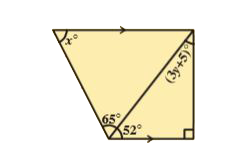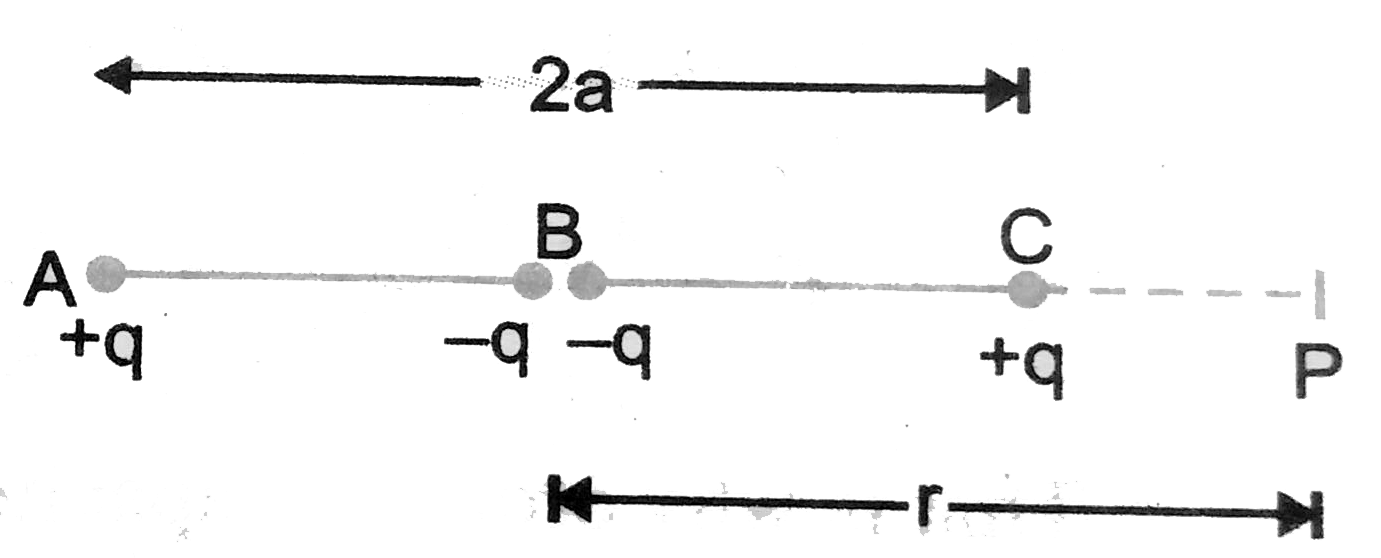Figure shows a charge array known as an electric quadrupole. For a point on the axis of the quadrupole, obtain the dependence of potential on 'r' for ra>>1, and contrast your result with that due to an electric dipole, and an electric monopole (i.e, a single charge)  Solution in Tamil
Solution in Tamil

Potential at P, V=V1+V2+V3+V4
=q4πε0(1(r+a)−1r−1r+1(r−a))=q4πε0(1(r+a)−2r+1(r−a))
V=q4πε0(r(r−a)−2(r2−a2)+r(r+a)r(r−a)(r+a))=q4πε0(r2−ra−2r2+2a2+r2+rar(r2−a2))
=2q.a24πε0r(r2−a2)=2q.a24πε0r.a2(r2a2−1)=2q4πε0r×r2a2=2qa24πε0r3
V varies for quadrupole as 1r3
V varies for dipole as 1r2
V varies for monopole as 1r
Topper's Solved these Questions
- ELECTROSTATIC POTENTIAL AND CAPACITANCEBOOK - NEW JOYTHI PUBLICATIONCHAPTER - ELECTROSTATIC POTENTIAL AND CAPACITANCEEXERCISE - Practice Problems For Self Assessment
23 Videos
- ELECTROSTATIC POTENTIAL AND CAPACITANCEBOOK - NEW JOYTHI PUBLICATIONCHAPTER - ELECTROSTATIC POTENTIAL AND CAPACITANCEEXERCISE - Evaluation Questions And Answers
41 Videos
- ELECTROSTATIC POTENTIAL AND CAPACITANCEBOOK - NEW JOYTHI PUBLICATIONCHAPTER - ELECTROSTATIC POTENTIAL AND CAPACITANCEEXERCISE - Competitive Exam Corner
22 Videos
- ELECTROMAGNETIC WAVES BOOK - NEW JOYTHI PUBLICATIONCHAPTER - ELECTROMAGNETIC WAVES EXERCISE - COMPETITIVE EXAM CORNER
16 Videos
- MAGNETISM AND MATTERBOOK - NEW JOYTHI PUBLICATIONCHAPTER - MAGNETISM AND MATTEREXERCISE - COMPETITIVE EXAM CORNER
13 Videos
Similar Questions
Calculating the work done in eV in carrying a charge +e Coulomb through a potential rise of 100 volts. (1.0eV=1.6×10−19joules)
View SolutionFill up.

View SolutionFrom the figure find x and y.

View SolutionIf the total electromagnetic energy falling on a surface is U, then the total momentum delivered (for complete absorption) is
View SolutionChoose the correct statement .
View SolutionFig shows a charge array known as an 'electric quadrupole'. For a point on the axis of the quadrupole, obtain the dependence of potential on r for r/a>>1, and contract your results with that due to an electric dipole and an electric monopole (i.e, a single charge).

View SolutionFigure shows a charge array known as an "electric quadrupole". For a point on the axis of the quadruple, the dependence of potential on r(r/agt gt1) is 1/(r^(n)) . Find n ?
View Solutionनीचे दिए गए चित्र 2.32 में के आवेश विन्यास जिसे विद्युत चतुर्ध्रुवी कहा जाता है, दर्शाया गया है । चतुर्ध्रुवी के अक्ष पर स्थित किसी बिंदु के लिए r पर विभव कि निर्भरता प्राप्त कीजिए जहाँ r/a>>1 । अपने परिणाम कि तुलना एक विद्युत द्विध्रुत व विद्युत एकल ध्रुव (अर्थात किसी एकल आवेश) के लिए प्राप्त परिणामों से कीजिए ।

View Solutionनिम्न चित्र में एक आवेश विन्यास जिसे विद्युत चतुर्ध्रुवी कहा जाता है, दर्शाया गया है। चतुर्ध्रुवी के अक्ष पर स्थित किसी बिंदु के लिए r पर विभव की निर्भरता प्राप्त कीजिए जहाँ r/a>>1 अपने परिणाम की तुलना एक विद्युत द्विध्रुव व विद्युत एकल ध्रुव (अर्थात किसी एकल आवेश) के लिए प्राप्त परिणामो से कीजिए।

View Solutionचित्र में प्रदर्शित चार आवेशों का संयुक्त निकाय विधुत-चतुध्रुव (electric quadrupole) कहा जाता है । निकाय के अक्ष पर केंद्र से r दूरी पर स्थित बिंदु P पर विभव का व्यंजक प्राप्त करें , यदि ar<<1. प्राप्त परिणाम की तुलना एक विधुत-द्विध्रुव (electric dipole) एवं विधुत एकल ध्रुव (electric monopole) के कारण विभव से करें ।

View SolutionElectric potential (ϕ) of a quadrupole varies with distance 'r' on its axis as :-
View SolutionThe figure given below shows a charge array known as an 'electric quadrupole'. For a point on the axis of the quadrupole, obtain the dependence of potential on r for (r )/(a) gt gt 1 . Contrast your result with that due to an electric dipole and an electric monopole (i.e. a single charge).
View SolutionDeduce an expression for the electric potential due to an electric dipole at any point on its axis. Mention one contrasting feature of electric potential of a dipole at a point as compared to that due to a single charge.
View SolutionFigure 2.32 shows a charge array known as an electric quadrupole. For a point on the axis of the quadrupole, obtain the dependence of potential on r for r/a>>1 , and contrast your results with that due to an electric dipole, and an electric monopole (i.e., a single charge).

View SolutionFigure 2.32 shows a charge array known as an electric quadrupole. For a point on the axis of the quadrupole, obtain the dependence of potential on r for r//a gt gt 1 , and contrast your results with that due to an electric dipole, and an electric monopole (i.e., a single charge).
View Solution
